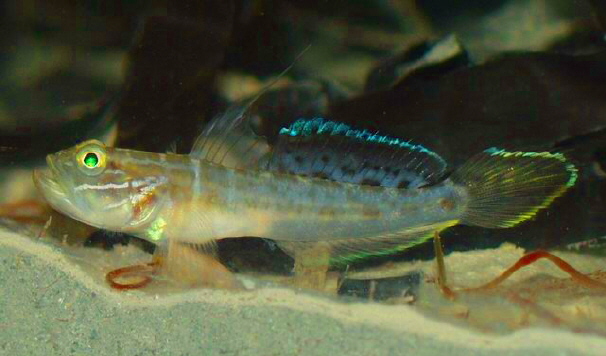The Axolotl (Ambystoma mexicanum) is an aquatic salamander.
It is noted for its appearance and its demonstration of neoteny, remaining in its aquatic larval form even as a sexually-mature adult, and not undergoing metamorphosis into a terrestrial form.
A fully grown axolotl, at age 18-24 months, ranges in length from 150-450 mm (6-18 inches), although a size close to 230 mm (9 inches) is most common and greater than 300 mm (12 inches) is rare. They have distinctive 'fern-like' gill structures that are not covered (as are gills in fish and in frog tadpoles) - usually 3 stalks on each side of the head; axolotls also breathe through the skin and possess lungs. In colour they range from albino or white (leucistic) to black, through greys, tans and browns. Wild axolotls are rarely white, though all leucistic (white with black eyes) axolotls are descended from a single mutant male brought to Paris in 1863 in a shipment to the Jardin des Plantes in the city. The true albino mutant common in labs and pet stores was created in an American laboratory in the 1950s through hybridization with an albino Tiger Salamander. No axolotls commercially available today are wild caught (since doing so is strictly forbidden), the majority being descended from these same research specimens, even in the pet trade.
Native to Lake Xochimilco and Lake Chalco in central Mexico, they also live in "axalapascos" (volcanic craters filled with water, maare). The wild population has been put under heavy pressure by the growth of Mexico City. Axolotls are also sold as food in Mexican markets, and were a staple in the Aztec diet. It is currently listed by CITES as an endangered species. In the Spanish language it is called the ajolote.
The axolotl is carnivorous, consuming small prey such as worms, insects, and small fish in the wild. In captivity, they can be fed a variety of readily available foods, including trout and salmon pellets, frozen or live bloodworms, earthworms, and waxworms on occasion. Beef Heart is sometimes recommended, but is not a good choice for the animal as mammal proteins are not readily digestible. Small juveniles can be fed with Daphnia or brine shrimp until old enough for the larger foodstuffs. Axolotls locate food by smell, and will "snap" at any potential meal, sucking the food into their stomachs with vacuum force. This is why other animals may not be housed with axolotls (excluding adults with adults) as anything smaller will invariably end up in their mouths - even siblings. Fish can also nibble an axolotl's gill stalks and appendages while it is asleep, leading to infection.
Axolotls live at temperatures of 14-20°C (54-68°F), preferably 17-18°C (62-64°F). Lower temperatures slow down their metabolism, although temperatures around 10 C (50 F) are a panacea when it comes to treating disease. Higher temperatures can lead to stress and increased appetite; use of a cooling aggregate is strongly recommended. In the wild, the water temperature in Xochimilco rarely rises above 20°C (68°F), though it may fall to 6 or 7°C (43°F) in the winter, and perhaps lower. Tapwater should be treated with a dechlorinator before the animal is introduced into it, as chlorine is harmful. A single typical axolotl should be kept in a normal 10 US gallon tank with around 150 mm (6 inches) of water. A full tank without a lid can lead to the animal "jumping ship" as it were. A power filter or underwater filter run by an airpump can be used, though water flow should be kept to a minimum to avoid stressing the animal. A 20% water change should be done every week, with debris being siphoned from the bottom. Small gravel should be avoided, as the axolotl can mistakenly ingest the rocks, leading to stress and gas. Floating plants should be provided for juveniles as a hiding place, and small caves should likewise be provided for adults. No light is necessary as axolotls are nocturnal. Axolotls will spend a majority of the time on the bottom of the tank (floating is a sign of stress and illness), so design accordingly.
Axolotls are very closely related to Tiger Salamanders (Ambystoma tigrinum). Some axolotls can metamorphose, although they do so rarely, and usually have to be treated with iodine or shots of thyroxine hormone to achieve the full transformation. The loss of the ability to produce the hormones on their own is what results in the animal's neotenic existence. Metamorphosis also dramatically shortens the axolotl's lifespan, assuming they even survive the process. A neotenic axolotl will live an average of 10-15 years (though an individual in Paris is credited with achieving 25 years), while a metamorphosed specimen will scarcely live past the age of five.
The axolotl is used in research and large numbers are bred in captivity. The feature of the salamander that attracts most attention is its healing ability: the axolotl does not heal by scarring and is capable of the regeneration of entire lost appendages in a period of months, and, in certain cases, more vital structures. Some have indeed been found restoring the less vital parts of their brains. They can also readily accept transplants from other individuals, including eyes and parts of the brain - restoring these alien organs to full functionality. In metamorphosed individuals, however, this ability is greatly diminished. Another attractive feature, for research, is the large and robust embryos. Axolotls are especially easy to breed compared to other salamanders in their family, which are almost never captive bred.
The name is from the Aztec Nahuatl language, from "atl" meaning water, and "xolotl" meaning dog. It also derives its name from the Aztec God of Death Xolotl, who - according to myth - assumed the amphibian's form in an effort to escape exile, and was killed while such.


 |
|||||||||||||





 Reply With Quote
Reply With Quote




























Bookmarks